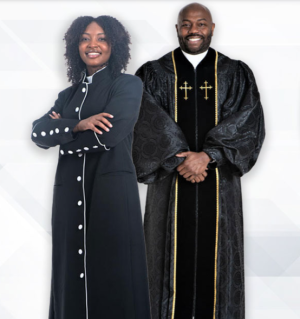The Art and Tradition of Clergy Attire: A Deep Dive into Its Heritage and Modern Adaptations
Contents
Key Takeaways
- The importance and lengthy history of clerical clothing in different religious traditions.
- Modern adaptations and how they reflect current societal changes.
- Insights into how clergy attire serves both functional and symbolic purposes.
Table of Contents
- Traditional Roots of Clergy Attire
- The Symbolism in Religious Vestments
- Modern-Day Adaptations and Practices
- Functional Aspects of Clergy Wear
- The Influence of Cultural Trends on Clergy Attire
- Sustainability and Ethical Considerations
- Common Questions About Clergy Vestments
- Conclusion: The Ever-Evolving Tradition
Traditional Roots of Clergy Attire
Clergy attire holds deep historical and spiritual significance, representing more than just clothing—it embodies tradition, devotion, and a lifelong commitment to service. These clothes have been essential to religious rituals and everyday life, representing authority and faith for ages. Each style, distinct from its spiritual tradition, conveys a sense of reverence and responsibility through its design. From simple robes and tunics to intricate vestments, the variety of clergy attire reflects the diverse spiritual practices worldwide. To explore the different styles and meanings behind these garments, visit https://www.divinityclergywear.com/ for further insights and visual representations of these traditional outfits.
The Symbolism in Religious Vestments
Every piece of clergy attire is carefully selected for its symbolic value, offering insight into the role of clergy members within their communities. The depth of meaning encapsulated in religious vestments is genuinely remarkable. Each garment is a visual liturgy, conveying teachings and beliefs through color, fabric, and design. Colors have particular significance; white often symbolizes purity and holiness, red may denote the blood of martyrs, while green, frequently seen in ordinary times, embodies growth and life. Materials, such as silk and wool, also play a part, chosen for their associations with wealth, sacrifice, and warmth. The unique designs and motifs denote rank, order, or specific liturgical significance. This symbolic language can be further explored through online platforms like Britannica’s comprehensive explanation of vestments, which opens the door to a world rich in religious art and iconography.
Modern-Day Adaptations and Practices
With the passage of time comes change. Even the most traditional garments are influenced by contemporary trends. The modern twist in clergy attire reflects the evolving nature of religious practice and societal integration. Contemporary adaptations might include less formal elements, such as shorter cuts or simplified designs that offer practicality without compromising symbolism. In today’s global economy, clergy have access to various materials and styles that were once geographically locked, allowing for a mix of tradition and modern elements. This cultural fusion is a testament to the resilience and adaptability of religious practices in a rapidly changing world, highlighting the balance between innovation and tradition that characterizes contemporary clergy attire.
Functional Aspects of Clergy Wear
Beyond symbolizing religious tenets, clergy attire must also serve practical purposes. These garments are designed to provide comfort and flexibility and meet the demands of an active role in spiritual and community life. Many clergy members spend long hours in these vestments, necessitating ease of movement and suitability for various tasks. Prioritizing practical aspects such as breathability for summer vestments or additional warmth for winter pieces ensures that clergy can focus on their duties without distraction. Furthermore, thoughtful design details to accommodate microphones or quick changes for different services reflect a pragmatic approach that respects both function and tradition.
The Influence of Cultural Trends on Clergy Attire
Cultural shifts and global communication have shaped everything from daily fashion to clergy attire. As congregations grow more diverse, the visual language of worship grows alongside, embracing multiculturalism in its aesthetic. This evolving trend is mirrored in clergy attire, where traditional garments may incorporate details from various cultures, embracing a shared spiritual journey. As congregations become increasingly diverse, so too does the attire of their leaders, allowing cultural exchanges to forge a visual expression of unity, respect, and inclusivity that recognizes and celebrates the global community’s contributions.
Sustainability and Ethical Considerations
Amid growing environmental concerns, sustainability has become essential in fabric selection and garment production, even for clergy attire. Environmentally focused initiatives within religious communities have prompted a shift toward sustainable fabrics, such as organic cotton or recycled fibers, minimizing the ecological footprint associated with garment production. As more congregations emphasize sustainability, the choice of clergy wear materials reflects a commitment to preserving creation. Ethical practices in sourcing and production align with the moral teachings of many faiths, encouraging responsible stewardship of resources and fair treatment of those involved in garment manufacturing. This shift underscores religious teachings and sets an example for the wider community to engage in more sustainable practices.
Common Questions About Clergy Vestments
- How often are clergy garments replaced or updated? Generally, replacements occur as garments wear out or styles evolve to suit changing liturgical or community needs.
- What are the most common colors used, and what do they represent? Colors like white, purple, red, and green each hold specific religious significance, often observed during liturgical periods.
- How do different denominations approach their attire traditions? While the fundamentals remain similar, the style and symbolism of vestments can vary significantly across religious denominations.
- What materials are typically used, and why? Durable yet symbolic materials like wool and silk are common because of their historical significance and metaphorical meanings.
These questions reflect many’s curiosity and respect for the intriguing world of clergy attire. Exploring these facets gives insight into these garments’ meticulous care and tradition.
Conclusion: The Ever-Evolving Tradition
The journey of clergy attire from its historical roots to its modern expressions is a testament to its enduring significance. While styles may adapt and change, the essence of these garments—signifying tradition, faith, and service—remains steadfast. This continuous evolution reflects the dynamic intersection of culture, tradition, and modernity, where change and continuity coexist harmoniously. As time progresses, clergy attire will continue to reflect the intersection of past wisdom and future possibilities, standing as a beacon of reverence and commitment.





I never realized how much meaning and tradition is woven into clergy attire. It’s amazing how something so simple-looking can carry centuries of history and symbolism. I really appreciated learning the “why” behind the designs!